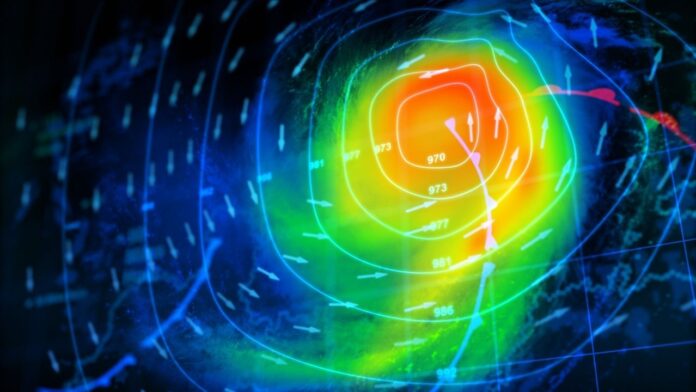The Early Days of Surf Forecasts
It is fascinating to discuss surf forecasts with the earlier generation of surfers. My favourite story of predicting conditions came from the late Donald Paarman, a legend of South African surfing. In the late 1960s and early 1970s, he would wake up before first light, check the direction of his homemade windsock, and take a deep inhalation of air into his lungs. He was adamant he could “taste and smell a groundswell.” If the windsock indicated an offshore breeze, and Don’s senses were stimulated, the surf was on its way.

Roll forward to the late ’70s and early ’80s. Surfers like renowned European explorer and surf break pioneer Paul Gill basically became amateur meteorologists. “The Gill” would study synoptic charts published in the daily newspaper to predict forthcoming swell and wind conditions. When the isobars aligned, he would drop everything and drive many hours to score perfect waves at secluded breaks.

During the mid 80’s and 90’s entrepreneurial surfers set up premium rate phone lines. These often carried a price tag of several dollars per minute. Surfers heard a pre-recorded message listing the conditions for various beaches up and down the coast. Although this system was revolutionary, surfers were frustrated at expensive seconds ticking by as they waited for the relevant report.
In the late 1990’s and early 2000’s, modern online surf forecasts exploded on the scene. The online format coincided with the introduction of mobile phones appearing in most surfer’s pockets. Surfers now had the opportunity to view a seven-day forecast from their computer before a surf trip. They could then receive real-time updates via mobile phone (albeit slightly slow and clunky with the old phones). This opened up a whole new era for the sport.
Several early game-changing websites are now leading the modern crop of forecasting websites and apps, alongside more recently established companies.
How do Surf Forecasts Work?
Modern surf forecasts collate detailed meteorological data from various sources and apply algorithms, swell models, and historical data comparisons. These formulas predict how the weather data will translate to local surfing conditions. Surfers enjoy colourful, user-friendly formats providing a concise breakdown of current and predicted conditions.
Most surf forecasts use data from the National Oceanic and Atmospheric Administration (NOAA) and other sources. Algorithms and models are often proprietary to the company, resulting in varying reports for the same surf zone.
How to Read a Surf Forecast
My advice is to spend time using daily reports and see how they cross over to conditions at local beaches. Over time this will allow you to use the forecasts to assess upcoming conditions. You might wonder why I suggest this.
The forecast says it’s going to be 3-4 foot, and offshore. It’s going to be 3-4 foot and offshore, right?
You’re going to have to trust me. I’ve committed endless hours driving to secluded surf spots, only to find conditions that don’t match the forecast. We need to consider a few relevant factors before studying how the forecast translate to your local breaks.
Swell Height is Not Necessarily Wave Height
Oceanic buoys provide the raw swell data from many kilometres out to sea. The movement reported between the peak and trough gives an accurate prediction of coastal swell conditions in the coming hours.
Unfortunately, the size of the ocean swell does not necessarily accurately represent the size of breaking waves at the beach. Factors such as coastal topography, wave decay and other scenarios can play a role. It is worth monitoring the size of the waves you actually ride compared to the reported swell.
Most forecasts now have wave size and swell size. However, these are based on algorithms, and nothing is as accurate as getting in the water and witnessing just how the swell reacts at your local break.

Wave Period
This is something that can often confuse surfers who are new to forecasting sites. Wave period is simply the amount of time in seconds between one wave and the next. I could write a whole article on the principles of wave period, but the essential factors are these:
Short Wave Period
- The shorter the wave period, typically under 10 seconds, the more likely the waves have been generated by short-range “wind swell” (2-300 miles off the coastline). These swells result in weak, smaller waves, which make for poor to average surfing conditions. It often catches surfers out when they arrive at the beach. Having seen a 2-meter swell forecasted, only to be met with gutless 2-3 foot waves due to the 6 second wave period.
Long Wave Period
- The longer the period, typically above 10 seconds but ideally above 12 seconds, the more likely the waves have been generated by long-range “groundswell ” (up to several thousand miles off the coastline). These are the swells that we live for as surfers, with lined up sets of waves breaking powerfully on our beloved beaches, reefs, and points. Often, at certain surf breaks, a high wave period of 14-20 seconds results in actual wave size significantly higher than the swell height, simply because of how the powerful, open ocean swell interacts with the reef or sandbanks.

Swell Direction
Most forecasts have a simple arrow that represents the direction a swell is traveling. It is vital to assess how the various swell directions affect the spot you plan to surf. It is easy to get a rough idea using Google Earth or coastal maps.
With a south swell (the waves are traveling from south to north), it’s not worth checking the northerly coastline. South-facing beaches will be receiving the brunt of the swell. East or west-facing shores might have waves, albeit smaller than the actual swell size due to wrapping around the coastline.
It is also worth noting how the swell direction affects your favourite reef or point break. One direction might peel perfectly down the point while a different direction pushes into the rocks, making for shorter rides.
Spending time learning how the swell direction affects your local breaks enables you to best use surf forecasts. This way you can accurately predict the quality of your surfing experience.
Wind Direction
Surfers love offshore winds, and forecast sites will inform you when optimum winds are on their way. Unless you are fortunate enough to live somewhere like Indonesia, offshore winds can be a bit of a rarity. It is well worth noting that some breaks tend to deal with non-offshore winds better than others. Surf forecasts can be a great way to assess the upcoming conditions and look for windows of opportunity.
During winter, my local coastline has pretty consistent groundswell conditions. When the wind blows offshore, there are around five different point breaks that absolutely fire. One left hand point break also produces high-quality waves when 12 second swells combine with a cross onshore wind. These conditions render all the other breaks unrideable. The ability to read the swell and wind conditions allows you to score sessions you might have missed out on.

10 Leading Surf Forecast Sites
SURFLINE

One of the most well-established surf reports and forecasts and was founded in 1985 by the late Sean Collins. Surfline is based in Southern California and provides a comprehensive wave forecasting website for users worldwide.
Surfline is an intuitive platform that allows you to briefly check the surf conditions at a glance. Surfers can study an in-depth forecast with real-time wind updates, local tide conditions, and storm tracking. Live HD footage is available from over 200 surf cams all over the globe. You can even spend a few hours reading and watching informative content created by experts within the surf industry.
The World Surf League (WSL) has adopted Surfline as the go-to forecast for every world tour event. This is a testament to the quality and accuracy of their models.
Surfline offers basic, free access as well as a premium membership. You can watch short surf cam streams, check the daily report, and view three-day forecasts for free. The full experience is accessed via a subscription of $7.99 billed at $95.88 annually. Students and military personnel receive a 50% discount.
Surfline caters to absolute beginners with easy-to-use fundamental forecasts. The site also enables seasoned pros to identify and track storms. This is essential when looking for the most giant waves in the most remote locations.
Surfline also set up live broadcasts of the mega swells that hit spots like Teahupoo or Cloudbreak.
MAGICSEAWEED

Founded in South West England in 2002, Magicseaweed ranks as one of the world’s largest and most visited surf forecast and surf report websites.
MSW provides an abundance of forecasting data and charts to dial into your local surf breaks. It is also effortless to apply the search function and find reports for spots you are planning to visit across the globe. The local photos are a great feature to get a feel for a beach you have never traveled to, often featuring professional-grade images from surf photographers. Live surf cams also feature on numerous breaks, enabling the would-be surfer to check live conditions. (Tip: remember what we discussed earlier about forecasts and local conditions. I often study a new break by comparing the report data and the live surf cam for a few days)
Magicseaweed uses a conditions rating system of one to five stars and color-coded wind directions of red, orange, and green to indicate if the winds are favorable or unfavorable.
Surfers are able to access seven days of forecasts for free, including short surf cam streams. A premium membership of $25.99 a year (payable $2.69 per month) provides a sixteen-day forecast, unlimited ad-free surfcam access, and additional swell insights from their panel of experienced surf forecasting experts.
MSW really stand out via their regularly updated archive of surfing-related content. They even have Surfdome, their online store where you can purchase the latest surf hardware and fashion.
SWELLNET

Initially founded by Ben Matson as a weather blog in 1998, Swellnet has become one of the most well established surf report and surf forecasting websites for Australian surfers.
Swellnet has excellent long range forecasting, but it also has a little bit of an old school feel to it in the sense that it doesn’t just rely on algorithms and models. The “obs” feature for many of the Australian breaks has a daily breakdown of the current and upcoming surf conditions from a local surfer. Offered as a dawn patrol and afternoon updates this is a great insight and will often dial a user into how the surf conditions will vary according to tide and changing wind. I think this is a brilliant feature and takes me back to when we used to ring our local surf shop from the school payphone to find out if it was worth running straight to the beach when the bell rang at the end of the day.
It is free to check surf cams, daily surf reports, and five-day surf forecasts, as well as the daily conditions observations. Pro membership of $8.95 gives you access to ad free surf cams, sixteen day forecasts, and further insights.
Swellnet’s core focus is Australia with large amounts of information available for the majority of breaks. Detailed reports are available for surf zones that Australian surfers visit regularly such as Indonesia. The detail reduces for other zones and there are no reports for the Americas.
SURF2SURF

Founded in 2004, Surf2Surf is one of New Zealand’s most popular and accurate surf report and surf forecasting sites.
Offering beautifully designed and easy to understand reports and forecasts for surf spots throughout NZ, Surf2Surf also gives you access to surf cams located at over 15 of the country’s best surf breaks. Surf2Surf has to be to be considered as the go to choice for New Zealand surfing.
I personally like how Surf2Surf and Swellnet are region specific. They have developed models for specific areas and the accuracy is usually very high. The fact that Surf2Surf offer a companion guidebook is a perfect touch for an extended trip, or for a local surfer looking to explore a new region.
Free access is in the form of a trial period. Full membership is $5.00 per month or $49.99 for an entire year, unlocking unlimited surf cam access, detailed reports, and long-range forecasts.
WINDGURU

Windguru was founded by Vaclav Hornik in the late 1990’s. The site was directed towards windsurfers and kite surfers, but soon became a staple of surfers due to it’s easy to use at a glance nature.
Windguru is fantastic at reporting and forecasting the wind conditions. You can access accurate wind data that outranks the majority of premium surf forecasting sites . One criticism of Windguru however, is that swell predictions are often a touch un-reliable when assessing wave heights at local spots. Although the wind forecast models and algorithms are incredibly sophisticated, the swell models are less so and not particularly adept at assessing local features that alter wave height, especially for the free version.
Windguru Pro is very reasonable at $21.00 per year and offers ad free usage and unlimited all forecast access. It also enables a custom spot feature, which is fantastic for adding your own secret spot, or surf zone that might not be featured on other platforms.
I personally always keep the Windguru installed on my phone. I use it for super accurate wind forecasts when the other forecasts are a bit conflicted. Windguru is usually spot on and gives me the confidence to travel to a spot that is very wind dependent.
WINDFINDER

The Windfinder home page is a stunning, colourful representation of global wind speed and direction. The site offers reports and forecasts for over 45000 spots around the world. There is particular relevance to kite surfers and windsurfers, with spots including marinas and launching places, as well as surf breaks.
There is an excellent database of webcams, offering the user the chance to check the live conditions at their local spots as well as across the globe.
Windfinder processes data from 21,000 weather stations. Wind speed, wind direction, air temperature, air pressure and other values can be viewed in real time.
Similar to Windguru in the sense that wave data is limited to swell height and direction, however the free to access wind reports, updates and forecasts can be invaluable for planning a trip, or deciding on a place to surf during a trip.
Windfinder offers both a basic forecast, for at a glance representation of the conditions as well as a super forecast, with enhanced data. I am a big fan of the accurate tide tables that Windfinder provides.
SURF-FORECAST

Surf-Forecast.com provides surf forecast and surf reports for over 7,000 surf spots. A point of difference that places Surf-Forecast in our top ten, despite strong competition, is the detailed surf break guide for each location. Optimum swell direction, wind direction and tide position are listed. The unique consistency guide informs the reader of an estimated percentage of the year that the spot has clean, blown out or small surfing conditions. This can be excellent when you are looking to visit a new surf zone and identifying the go-to spots.
Users are able to set up custom email alerts to notify them when conditions align at their favourite surf spots, as well as confirming the report via live surf cam.
If I have one minor criticism of Surf-Forecast it is that the reports are quite “busy” looking, with lots of information to take in, and quite small text to read, compared to the clean looks of Surfline or Magicseaweed.
SWELLINFO

Swellinfo is a fantastic resource for the Americas, providing comprehensive forecasts and reports for The United States, Mexico, Central America and The Caribbean.
Swellinfo forecasts are simple enough for novices to understand, but include all the detailed weather data and charts required by the more experienced surfer. The platform is simple and the relevant data is presented nicely. Being a free to view site the advertisements can get a little tiresome but if you can handle the odd banner and pop up it is well worth it.
The site presents you with a satellite image of the area you are checking, allowing you to zoom in and see how the shape of the coastline might receive the incoming swell, as well as how the wind will affect the waves.
Swellinfo work on the basis that they are giving you all the information you need for a successful surf trip. The platform isn’t as smooth as the more established premium sites, however, it’s a great resource for planning your session, with some interesting post surf content to read when you’re surfed out.
WINDY.COM

Windy is not technically a surf forecast site. It is a comprehensive free weather reporting and forecasting resource offering detailed information that surfers canuse to accurately forecast the upcoming wave conditions.
With a little practice and patience you will be paying tribute to the old school surfers by reading the charts to predict swells, with the added bonus of wind speed and swell size data at the push of a button.
Windy shows everything in stunning, colourful animation. You cannot access specific data for surfing spots like the other sites listed, but moving the cursor around the map shows you how the swells travel towards the coast. Windy also has, in my opinion, the most beautiful homepage of any website going.
I really do encourage you to take a look at Windy and spend some time learning the different layers you can apply to the map, particularly the wind and swell layers. In time you will be able to track weather systems and even pick up on incoming swells before some of the forecast sites.
UK MET OFFICE

The Met Office is the national meteorological service for the United Kingdom. If you want to take your swell predicting skills to the next level, pressure (or synoptic) charts and coastal wave conditions are an incredibly valuable resource.
The site provides detailed weather charts and even offers tutorials for how to accurately read them. With a bit of practice you will be able to spot the difference between high and low pressures, predict wind directions and even swell direction.
Once you learn the optimum chart for your chosen surf zone, it is enthralling to watch the systems develop and the anticipation of a potential swell is a great feeling.
The Met Office have forecast UK surf conditions for a little while now, however there is not yet an official platform.
Check out the site if you are interested in how to interpret the weather and wave conditions, although trust me it can become a little bit addictive.
Summary
As you can see there are an abundance of surf forecasts available to us as surfers. We have access to all the data we need to obtain accurate predictions, allowing us to score more waves than ever before.
The premium sites such as Surfline and Magicseaweed are definitely setting new standards. However, the smaller regional sites offer surfers the opportunity to really tune into the dynamics of their surf zone.
There are sites for those of us who aspire to the more meteorological approach to surf forecasting. The Met Office and Windy.com enable us all to become amateur storm chasers.
I hope this article has given you an insight into the 10 best surf forecasts. I also hope I have given you a bit of information regarding how to best utilise them in the pursuit of perfect waves.





